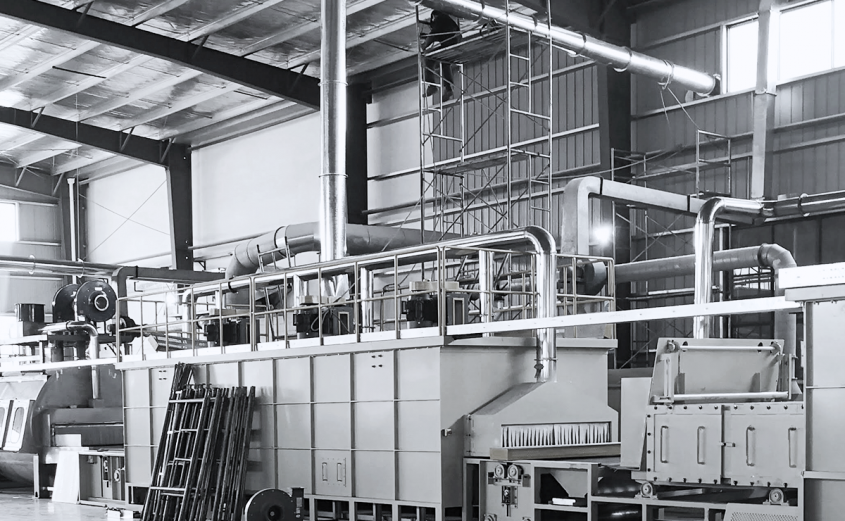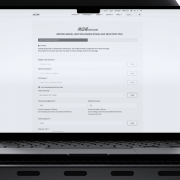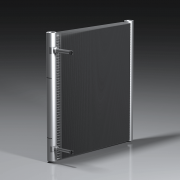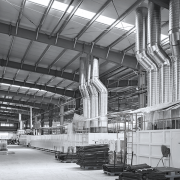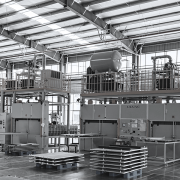MCHE brazing process in detail
Brazing is the joining of metals – aluminum, in the case of microchannel heat exchangers – with the use of molten filler metal. During melting, the filler metal spreads between the closely fitted parts and forms a fillet around the joints. This creates a metallurgical bond when cooled.
Brazing Process Sequence
The most common process sequence consists of the following steps:
- Assembling
- Fixturing
- Degreasing
- Fluxing
- Drying
- Brazing
- Cooling
- Testing
Certain heat exchanger components can be pre-fluxed using flux paint consisting of the flux itself, carrier and binder. Pre-fluxing is practical for internal parts such as baffles (dividers), side supports, and, in some cases, heat exchanger manifolds.
Fixturing
Fixtures are necessary to hold the coil core assembly in place during brazing and to maintain shape and tolerances during heat-up.
The configuration and material of the fixtures should be selected in consideration of the thermal expansion differential between fixtures and braze assembly to minimize compression during heat-up in the CAB furnace.
The preferred material for fixtures is AISI 316, however, most stainless steel alloys are acceptable. It should be noted that aluminum expands much faster than stainless steel, which must be taken into consideration in order to prevent the distortion of the heat exchanger at brazing temperature. Moreover, molten filler metal dissolves stainless steel. Thus, it is essential to minimize contact between fixtures and filler alloy.
Degreasing
Thermal degreasing takes place by elevating the temperature of the heat exchanger and is targeted to flash off lubricants present on surfaces. Particular types of lubricants, known as vanishing oils, should be used for this purpose.
The process of thermal degreasing starts after the heat exchangers are assembled and fixtured by loading batch-wise into a thermal degreasing station and exposing them to a suitable time-temperature cycle to flash off the lubricants.
Time-temperature cycles should be adjusted to produce wettable surfaces on aluminum. A contact angle between the aluminum surface and liquid droplets of greater than 90 degrees results in a wettable condition. A wettable condition is preferred for applying flux slurry to the heat exchanger assembly, therefore, selecting the correct degreasing method is essential. To achieve wettability within a short period of time, temperatures must be high (approx. 3 minutes at 280°C or higher temperature, approx. 10 minutes at 200°C).
Another option is to add a wetting agent or low-foaming non-ionic surfactant to the flux slurry. Surfactants work by lowering the surface tension of liquid in the flux slurry, which will then cause the slurry to uniformly coat the heat exchanger without running off. Surfactant concentration in flux slurry must be low, from 0.05% to 0.50%. Surfactants should be added to flux slurry incrementally until wettability is achieved. Excessive surfactant concentration may lead to loss of brazeability and lower corrosion performance.
Fluxing
There is a natural oxide film on aluminum surfaces. This oxide layer is thin (0.01µ or less) but extremely hard and tenacious with a high melting point. When an aluminum surface is scratched, the oxide film instantaneously reforms. It is this oxide that gives aluminum excellent corrosion properties.
Oxide film must be displaced/destroyed to allow brazing since metallurgical bonds only occur between metal surfaces. Once molten, the flux’s primary role is to dissolve the oxide layer on aluminum surfaces to be joined and prevent re-oxidation during brazing.
Also, flux wets aluminum surfaces, thus allowing the filler metal to flow freely into the joints by capillary action. After cooling, the flux remains on the brazed component as a thin, tightly adherent film, which does not need to be removed.
Flux is sprayed at the fluxing station to form a thin, uniform layer on all active brazing surfaces. The minimum amount of flux required to dissolve a 0.01µ oxide film is about 2.0 g/m²; however, in practice, loading for fluxing is from 3 to 5 g/m², uniformly distributed on all brazing surfaces.
Flux penetrates the oxide layer and lifts and separates the oxide from the base aluminum. Most of the oxide appears to float on top of the molten flux, whereas the rest of the oxide is submerged and dissolves in the molten flux.
After brazing, the oxide remains as part of the flux residue. Aluminum surfaces will re-oxidize immediately, including surfaces with flux residue.
Insufficient flux will result in deficient filler metal flow, poor joint formation and inconsistent brazing. Excessive flux amount applied will not affect brazing results, however, the surface of the brazed product will appear gray with visible signs of flux residue.
Wet Fluxing
Deionised or reverse osmosis water should be used to make up the flux slurries. Flux slurry concentrations to use depend on many factors affecting flux loading, including the type of application (atomized spray, shower) and typically selected experimentally.
The slurry is held in a reservoir tank and continuously agitated to prevent settling. When required, the slurry is pumped into a flux slurry cabinet where the heat exchangers are sprayed, whilst moving on a conveyor. After spraying, the excess flux slurry is blown off in a separate chamber with high-volume airflow.
Dry Fluxing
Dry fluxing is a technology whereby the flux is electrostatically charged and applied to the grounded heat exchangers. The electrostatic attraction causes a flux layer to be deposited on the heat exchanger surface. The flux application system consists of a powder feed system, an electrostatic spray gun and a gun control unit.
Since the flux is applied dry, there is no need to prepare flux slurry and treat wastewater generated by the fluxing station. The dehydration section of the CAB furnace may be eliminated as well.
The drawback of dry fluxing is a lower level of flux adhesion compared to that of wet fluxing.
Drying
Heat exchanger surfaces should be dehydrated before entering the brazing furnace. The dry-off section of the furnace is intended to remove water from the fluxing operation. The amount of water carried into the dry-off section depends on the flux slurry concentration used.
The dry-off temperature should not be higher than 200°C to prevent aluminum oxidation that can occur in a moist atmosphere with higher temperatures. With little moisture in the furnace atmosphere, a dry-off process is possible with temperatures up to 400°C without the occurrence of aluminum oxidation.
Brazing
Brazing Atmosphere
For reliable brazing, the furnace atmosphere conditions should be as follows:
- Dew point: < –40°C
- Oxygen concentration: < 100ppm
- Inert gas: nitrogen with moisture content < 1.5ppm
Moisture content in the critical brazing zone of the furnace is a crucial indicator of the quality of the brazing atmosphere.
Time-temperature Profile
The time-temperature profile of the brazing process is a key to achieving high-quality, corrosion-resistant heat exchangers. The following performance parameters must be maintained during the brazing process:
- Heating rate: minimum average heating rate of 20°C/min up to the maximum brazing temperature. For large heat exchangers, lower heating rates may be used with higher flux loadings. Maintaining temperature uniformity across the heat exchanger becomes increasingly difficult with faster heating rates.
- Maximum brazing temperature: For most aluminum alloys, the peak brazing temperature is anywhere from 595°C to 605°C.
- Time at temperature: Heat exchangers should not remain at the maximum brazing temperature for any longer than 3 to 5 minutes. The reason for this is that a phenomenon known as filler metal erosion begins to occur. The longer the filler metal remains molten, the more severe the erosion is.
- Temperature uniformity: During heat-up, temperature variations may occur across the heat exchanger and these variations will tighten as the maximum temperature is reached. At brazing temperature, variations should not exceed ±5°C.
Figure 1: Time-temperature profile
Reactions During Heat-up and Brazing
- 90°C – 150°C: Driving off moisture from the fluxing operation.
- 290°C – 350°C: Progressive release of chemically-bound water in the flux.
- 350°C – 565°C: Potassium tetrafluoroaluminate vaporizes and reacts with moisture.
- 565°C: The flux begins to melt.
- 577°C – 600°C: The filler metal begins to melt, flows and forms fillets at joints.
- Cooling: The filler metal solidifies; the flux solidifies and remains on the surface as adherent residue (1 to 2 microns thick).
Figure 2: Reactions during heat-up and brazing
Flux Residues
The flux residue is non-corrosive, non-hygroscopic and insoluble in aqueous media. The flux residue was never intended to be removed from brazed surfaces.

